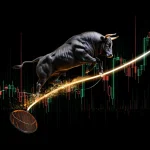Multi-Time frame Analysis: How to Stop Guessing and Start Hitting It Big
April 12, 2025
Introduction:
The stock market is a volatile, emotional beast. It doesn’t move in straight lines. One minute it’s soaring, the next it’s crashing, often seemingly for no reason. But here’s the brutal truth: unless you stop guessing and start seeing the market for what it really is—a multi-dimensional, emotional beast—you’ll be dragged along like a helpless victim in a storm. That’s where Multi-Timeframe Analysis (MTFA) steps in—a method that allows you to slice through the chaos and see the true directional forces at play. Forget predicting where the market will go in the next few minutes. Start understanding how to capture the trend across time—or bleed like a pig.
The Market is an Emotional Beast—Don’t Let it Control You.
It’s all about psychology, pure and simple. The market reflects human emotions—fear, greed, FOMO, regret—and these emotions ripple across time. A short-term rally might be fueled by excitement, while a long-term uptrend could be pushed by institutional buy-ins or global shifts in sentiment. The key isn’t just knowing where the price is now—it’s understanding where it will be in the larger time frame and how the smaller fluctuations feed into that big-picture movement.
That’s where Multi-Timeframe Analysis comes into play. If you’ve been trying to figure out the market using just one chart, you’re blind to what’s happening beneath the surface. MTFA takes a multidimensional approach, drawing from hourly, daily, weekly, and monthly charts to create a map that gives you both the immediate signals and the long-term direction. Without it, you’re like a sailor in a storm, blindly trying to steer your ship with no compass.
Why Multi-Timeframe Analysis Works: The Power of Alignment
Imagine you’re trying to navigate a treacherous sea. You’re sitting in the cockpit of your ship, looking at a radar that only gives you a snapshot of the waters ahead. But with a Multi-Timeframe approach, it’s like getting a full ocean view. You see the waves, the tides, the undercurrents, and the storms brewing in the distance.
The trick to hitting it big in the stock market isn’t about chasing every little price tick but alignment. This is the magic sauce. When you line up the trends from multiple time frames—hourly, daily, weekly, and monthly—the market doesn’t just whisper to you; it yells. And when the signals converge across these time frames, you no longer have to guess. You can make strategic, informed decisions based on a clear, calculated picture of where the market is headed.
Here’s the catch: the longer time frames, like weekly and monthly charts, give you the big-picture view. Meanwhile, the smaller, more immediate time frames, like hourly or daily charts, give you the tactical advantage. The ultimate goal is to recognize when the short-term fluctuations align with the long-term trends—that’s when you know you’re in the right trade.
The Bigger Picture: Using MTFA to Filter Out Noise
In the world of trading, noise is the enemy. Every day, a barrage of data, rumors, headlines, and gut reactions cloud your judgment. It’s easy to get caught up in the day-to-day market movements, buying on euphoria or selling on panic. Multi-timeframe analysis helps you cut through that noise by allowing you to focus on the bigger trend.
Here’s how it works: Let’s say you’re looking at the hourly chart. You might see a sharp price drop, and panic sets in. You think, “This is it, I’m out!” But then you zoom out to a daily chart and notice that the dip is just a blip on the radar—a natural pullback in an ongoing uptrend. Now you have perspective. If you add a weekly chart, the dip might be nothing more than a tiny pause in a larger, powerful rally. Instead of making impulsive decisions based on short-term noise, you can step back and see the market for what it is—a trend in motion.
That’s the beauty of MTFA—it lets you ignore short-term distractions and focus on long-term momentum instead. This doesn’t mean you ignore smaller signals—it means you contextualize them. If everything aligns—if the short-term trends align with the long-term direction—you’re not guessing. You’re reacting to what the market is telling you.
The Role of Mass Psychology (MP): Understanding Market Sentiment
Now, let’s add the psychological element to the mix. While MTFA gives you the technical edge, Mass Psychology (MP) is the secret sauce that turns it into a weapon. The market doesn’t move purely based on fundamentals or charts—it moves because of human emotions. Fear, greed, and herd mentality shape every price movement. And those emotions manifest differently depending on the time frame.
When you look at a daily chart, you see traders’ emotional responses for weeks. On a weekly chart, you’re looking at the collective sentiment of institutional investors, who may have more patience and bigger stakes. On a monthly chart, the emotional momentum could be driven by global events, major economic shifts, or long-term policy changes.
For example, during the 2008 financial crisis, markets plunged in a panic-fueled selloff. The hourly and daily charts were filled with volatile swings as emotions ran high. But if you zoomed out to a weekly or monthly chart, you saw a different story: an overreaction to systemic issues that eventually led to a recovery. By applying Mass Psychology, we understood that the collective fear would eventually give way to hope, and long-term investors could capitalize on the rebound.
You get the power of timing by using MTFA in conjunction with MP. You don’t just see the chart—you understand why it’s moving, what’s driving the sentiment, and how long that sentiment is likely to last.
The Dangers of Blind Trading: Why Guessing is a Recipe for Disaster
You’ve probably seen it happen before—investors who act impulsively, jumping in and out of trades based on the latest headline or tweet, only to be crushed by the market’s unpredictability. That’s because they’re not reading the market—they’re guessing. And when you think, you open yourself up to big losses.
Imagine being in a position where the market is rising, but you’re only looking at short-term charts. You might think it’s a bubble ready to burst. You sell. But then you zoom out, and the larger trend is still in a strong uptrend. You were just wrong in your short-term assumption. Without MTFA, you would’ve missed out on massive gains.
This is where cognitive biases, like anchoring (getting fixated on a single data point) or recency bias (overweighting recent events), come into play. These biases distort your perception of the market. MTFA lets you bypass these traps by giving you a fuller picture of what’s happening now and why and how the market’s sentiment will likely evolve.
Real-World Example: How MTFA and MP Could Have Helped in 2020
Let’s take a real-world example: the COVID-19 pandemic. The market plunged in the early days of the crisis as panic set in. You might have sold out in fear if you’d been trading based on just the hourly or daily charts. But if you’d zoomed out to a weekly or monthly chart, you would have seen something else: the beginning of a massive recovery rally.
By using MTFA in combination with MP, you can understand that the emotional extremes of fear were temporary. Markets reacted to immediate uncertainty, but underlying trends—stimulus measures, global cooperation, and recovery optimism—were poised to push the market back up. Strategically, the correct move would’ve been to hold or buy more during that dip instead of getting swept up in short-term panic.
How to Implement MTFA and MP for Maximum Results
The real power of MTFA comes when you combine it with an understanding of market psychology. Don’t just look at the charts—understand the human emotions driving them. Here’s how you can use both tools for maximum impact:
- Use multiple time frames to get the big-picture trend and the smaller, tactical signals.
- Align your analysis. When all time frames converge (e.g., oversold conditions across hourly, daily, and weekly charts), you can act with confidence.
- Understand the sentiment—know when the market is driven by fear or greed and how these emotions affect the long-term trend.
By integrating MTFA and MP, you’ll stop guessing and start making informed, strategic trades. It’s not just about catching the next big trend—it’s about understanding the why behind the moves and positioning yourself to take advantage of it.
Conclusion: Don’t Guess. Master the Market.
The stock market is not a guessing game. It’s a science—a psychological game of human behavior and technical analysis. Multi-Timeframe Analysis is your key to unlocking its hidden patterns, while Mass Psychology lets you understand the emotional currents that drive those patterns. Master these tools, and you’ll stop bleeding like a pig and start hitting it big.
The choice is yours: continue to guess or master the art of trading with a complete, multidimensional view of the market. The clock is ticking—start hitting it big, or be left behind.
Beyond the Obvious













